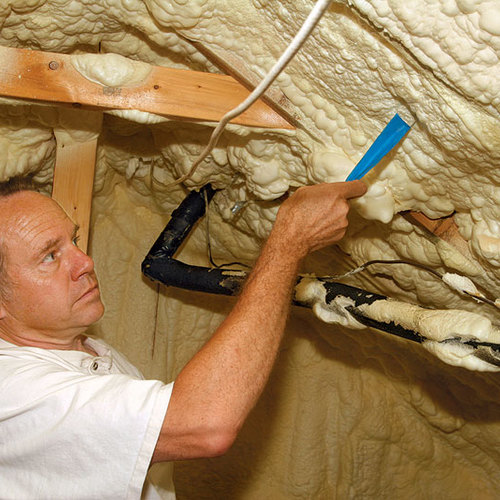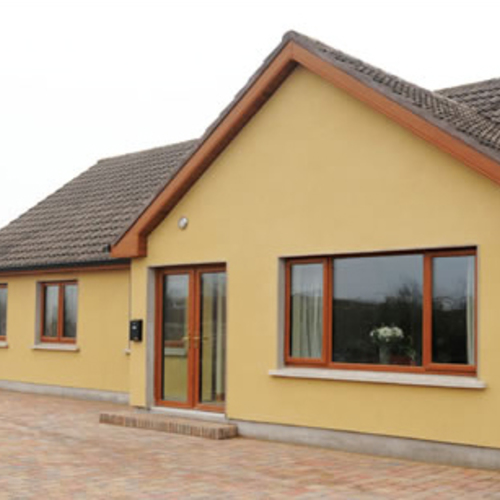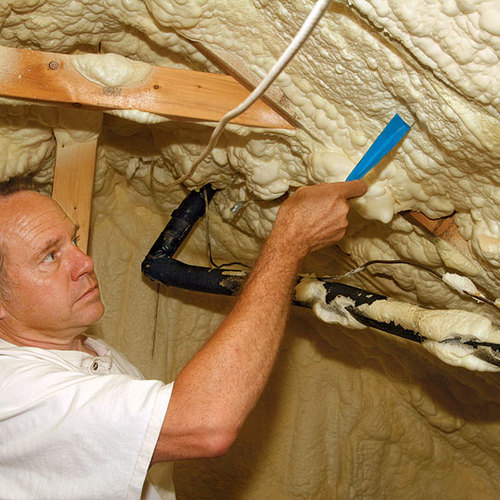
Rich Cowan lives in an 1,800-square foot bungalow in northern Massachusetts that has been renovated twice in the last decade but still has some problems: no insulation in the basement, and a furnace and air handler in the vented attic.
“The heat produced by our gas furnace is quickly moving through the ceilings to a vented attic, and then is lost forever,” Cowan writes in a Q&A post. Money to correct the problems is not unlimited, but Cowan has a plan.
First and foremost, he wants to turn the attic into a conditioned space to reduce the stack effect that now draws cold air into the lower sections of the house. He hopes to use spray polyurethane foam and has talked with two installers.
One installer suggests 5 in. of closed-cell foam under the roof deck and 3 in. in the gable ends. The other wants to completely fill the 10-in. rafter bays with open-cell foam and put 3 1/2 in. in the gable ends. Both approaches would require intumescent paint as an ignition barrier on the foam if the space isn’t finished in drywall.
He likes the open-cell approach and plans to build staggered stud walls in the gable ends to hold more insulation. Plus, he could spray the fire retardant paint himself.
Among Cowan’s concerns are thermal bridging, how to provide a vapor retarder in the roof and gable ends, and whether the gas furnace is a fire hazard.
His situation is more complicated than it may look, and it’s the topic of this week’s Q&A Spotlight.
Where’s the best place to start ?
Although Cowan is focused on the attic and says he’ll tackle the basement issue down the road, the basement is exactly where Ottobounds would have him start.
“You mentioned…
Weekly Newsletter
Get building science and energy efficiency advice, plus special offers, in your inbox.

This article is only available to GBA Prime Members
Sign up for a free trial and get instant access to this article as well as GBA’s complete library of premium articles and construction details.
Start Free TrialAlready a member? Log in














7 Comments
Venting the attic
I would suggest that cardboard insulation baffles be installed in the rafter bays prior to spraying the foam insulation. There is plenty of rafter depth available and the homeowner can easily do this job. This way you can protect the roof sheathing and roofing materials from moisture and heat degradation. Make sure the baffles are linked to soffit and ridge venting.
Attic
Would cellulose even need a fire barrier? Its another option to consider. Stll would be a VB issue but it would might take one issue off the table.
Venting the Attic
I installed one by two strips on each side of the rafters and then placed rigid insulation over those. I filled in the remaining space with fiberglass insulation and installed a plastic vapor barrier over that. Then I installed drywall over that. This gave me a vent into the attic ceiling from the knee wall area.
bungalow retrofit
I'd like to suggest a "not too sexy retrofit". First, get the furnace out of the attic ! Throw it away if it is low efficiency , but in any case install a high efficiency furnace in the basement. Use the attic for storage but before you fill it up with useless unwanted stuff, insulate the space under the floor with densely packed cellulose. And about the " stack effect", you can't eliminate it. The house will leak from the stack effect as long as the sun rises and grass grows. Sealing the leaks between the house and the attic will lessen the impact of the stack effect. If the space under the floor is only 6 inches , you can add some foam on top of the floor to boost the r-value and minimize thermal conduction thru the joists and then lay some osb or plywood on top for a new floor.
Vapor barrier
Am I missing something? What's the problem with vapor? I thought vapor barriers were a big no no. I thought that its best to allow the movement of vapor, but not air.
Why not go with the open cell, because its better for the environment. Add some cross members to pad out the wall for greater depth of insulation and to cut down on thermal bridging. If you're still worried about moisture, put in an HRV. They have a low energy draw and are great for heat conservation and fresh air.
Somebody comment and let me know if I'm way off base here.
Response to Patrick Kitzmiller
Patrick Kitzmiller ,
While closed-cell foam is fairly impermeable to the diffusion of water vapor, open-cell foam is fairly vapor-permeable. That doesn't make the product better or worse -- just different.
If you spray open-cell foam against the underside of your roof sheathing, the fact that the foam is vapor-permeable is a disadvantage during the winter months. In Climate Zones 6 and 7, humidity from the interior of the house can diffuse through the foam and accumulate in the cold roof sheathing. Several researchers have documented this phenomenon as far south as Boston.
No one wants damp roof sheathing. Depending on how humid your house is, and how cold your climate is, the roof sheathing could eventually rot.
The solution is to spray the interior surface of the cured foam with vapor-retarder paint. Most manufacturers of open-cell spray foam (including Icynene) require the installation of a vapor retarder on the interior side of the cured foam in cold climates.
I would do what is called
I would do what is called 'flash and batt' on the roof deck. 2 inches of closed cell foam sprayed straight on the roof deck and finishing up with fiberglass batts with the vapor barrier facing in. Cold roof decks are only necessary to prevent ice damming at the eaves - if the top plates and eaves are sprayed with foam this won't be an issue.
Log in or become a member to post a comment.
Sign up Log in